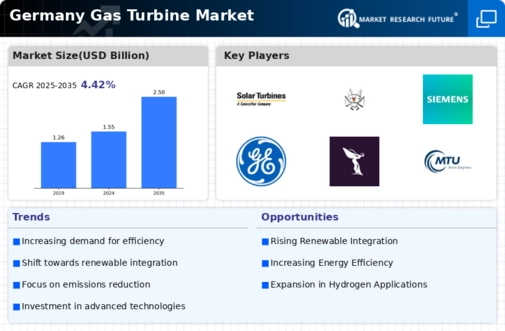Regulatory Support for Clean Energy
The gas turbine market in Germany is experiencing a notable boost due to robust regulatory frameworks aimed at promoting clean energy solutions. The German government has implemented various policies that encourage the adoption of low-emission technologies, which directly benefits the gas turbine market. For instance, the Renewable Energy Sources Act (EEG) incentivizes the use of gas turbines in conjunction with renewable energy sources, thereby enhancing their appeal. Furthermore, the European Union's Green Deal aims to reduce greenhouse gas emissions by at least 55% by 2030, which aligns with the operational efficiencies of modern gas turbines. This regulatory support not only fosters innovation but also attracts investments, as companies seek to comply with stringent environmental standards. Consequently, the gas turbine market is likely to see increased demand as industries pivot towards sustainable energy solutions.
Investment in Infrastructure Development
Investment in infrastructure development is a critical driver for the gas turbine market in Germany. The government and private sector are increasingly allocating funds towards upgrading and expanding energy infrastructure to meet future energy needs. This includes the construction of new power plants and the retrofitting of existing facilities with advanced gas turbine technology. Recent reports indicate that Germany plans to invest over €30 billion in energy infrastructure by 2030, which will significantly impact the gas turbine market. Such investments not only enhance the capacity and reliability of energy supply but also facilitate the integration of renewable energy sources. As infrastructure projects progress, the demand for gas turbines is expected to rise, providing manufacturers with ample opportunities to expand their market presence. This trend underscores the importance of infrastructure in shaping the future landscape of the gas turbine market.
Rising Energy Demand in Industrial Sectors
The gas turbine market in Germany is significantly influenced by the rising energy demand across various industrial sectors. As the economy continues to grow, industries such as manufacturing, chemicals, and automotive are experiencing increased energy consumption. According to recent data, industrial energy consumption in Germany is projected to rise by approximately 2.5% annually over the next few years. This surge in demand necessitates reliable and efficient power generation solutions, positioning gas turbines as a viable option. Their ability to provide flexible and responsive power makes them particularly suitable for industries that require a stable energy supply. Additionally, the gas turbine market benefits from the trend of industries seeking to transition from coal to cleaner energy sources, further driving the adoption of gas turbines. This growing energy demand is likely to propel the market forward, creating opportunities for manufacturers and service providers.
Focus on Energy Security and Diversification
The gas turbine market in Germany is increasingly driven by a focus on energy security and diversification of energy sources. In light of geopolitical uncertainties and the need for reliable energy supply, the German government is prioritizing the development of a resilient energy system. Gas turbines, known for their quick start-up times and operational flexibility, are becoming essential in ensuring energy security. The market is witnessing a shift towards diversifying energy sources, with gas turbines playing a crucial role in balancing the grid and supporting intermittent renewable energy generation. This strategic focus is reflected in Germany's energy policy, which aims to reduce dependence on single energy sources and enhance overall energy resilience. As a result, the gas turbine market is likely to benefit from increased investments and demand, as stakeholders seek to create a more secure and diversified energy landscape.
Technological Advancements in Turbine Efficiency
Technological advancements play a pivotal role in shaping the gas turbine market in Germany. Innovations in turbine design and materials have led to significant improvements in efficiency and performance. For example, the latest generation of gas turbines boasts thermal efficiencies exceeding 60%, which is a remarkable achievement in the industry. These advancements not only reduce operational costs but also lower emissions, making gas turbines a more attractive option for power generation. The integration of advanced control systems and predictive maintenance technologies further enhances the reliability and efficiency of gas turbines. As industries in Germany increasingly prioritize energy efficiency and sustainability, the demand for high-performance gas turbines is expected to rise. This trend indicates a strong growth trajectory for the gas turbine market, driven by continuous technological evolution.




















Leave a Comment